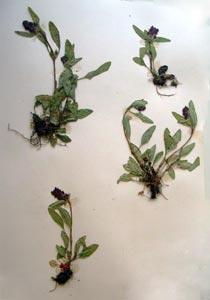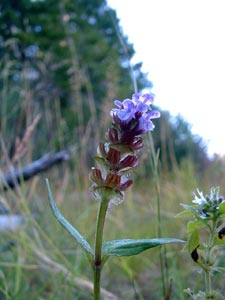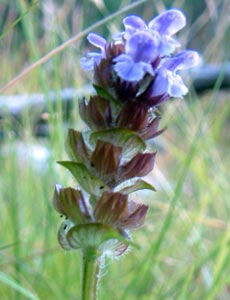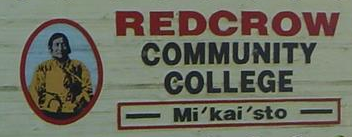Selfheal – Prunella vulgaris (Woundwart, Heal All)

Sommer in the field picking plants.
(Glenbow Museum. (2005). Nitsitapiisinni Exhibit. Calgary, Alberta: Blackfoot Gallery Committee)
Selfheal

Prunella vulgaris
Galileo Educational Network
Selfheal, also known as Woundwart or Heal All, belongs to the mint family. It grows in moist places at the edge of woody areas, scrubby patches, and near bodies of water. The plants grow to 10-30 cm tall. In July and August violet/purple/blue flowers, sometimes with white streaks, bloom. The flowers are together in 10-15 mm spikes at the top of the plant. The leaves are a medium green colour, a little hairy, and can be quite long, anywhere from 2.5-10 cm.
A strong tea made from the Selfheal plant can be used in different ways. It can be used to wash out a boil that has popped, or put on neck sores. It can be used as eyedrops to keep eyes from drying out on cold or windy days. You can also use the tea on horses as an eyewash, or put it on any saddle sores or back sores the horse may have.
Prunelle vulgaire

Prunella vulgaris
Galileo Educational Network
La prunelle vulgaire, aussi connue sous le nom de brunette ou de brunelle, appartient à la famille de la menthe. Elle pousse dans des lieux humides, à l’orée des bois ainsi que près des arbustaies et des cours d’eau. Cette plante peut mesurer de 10 à 30 centimètres de haut. En juillet et en août, des fleurs de couleur violette, pourpre ou bleue y poussent. Ces fleurs peuvent avoir des rayures blanches. Elles poussent en haut de la plante, en épis de 10 à 15 millimètres. Ses feuilles quelque peu velues sont d’un vert moyen, et elles peuvent mesurer de 2,5 à 10 centimètres, ce qui est assez long.
Le thé fort fait à partir de la prunelle vulgaire a de nombreux usages. Il peut servir à nettoyer un clou qui a éclaté ou à atténuer les douleurs du cou. Il peut aussi servir de gouttes pour humidifier les yeux pendant les journées froides ou venteuses. Ce thé peut aussi être utilisé pour nettoyer les yeux des chevaux ou encore, pour soulager ses maux de garrot ou de dos.

Prunella vulgaris
Galileo Educational Network
- Hellson, John C. (1974). Ethnobotany of the Blackfoot Indians. Ottawa: National Museums of Canada.
- Moerman, Daniel E. (1998). Native American Ethnobotany. Portland: Timber Press.
- Vance, F.R., Jowsley, J.R. & Mclean, J.S. (1984). Wildflowers Across The Prairies. Saskatoon, Saskatchewan: Western Producer Prairie Books.





